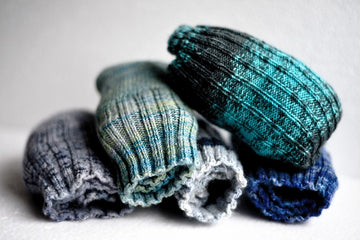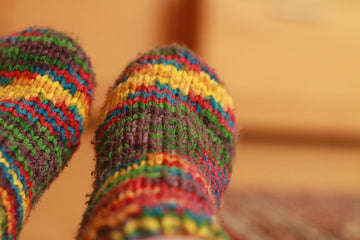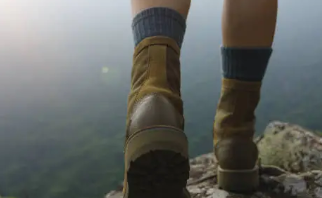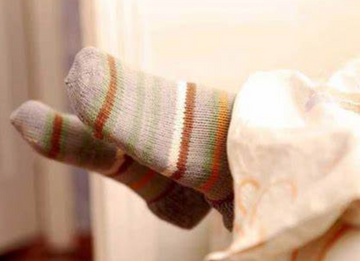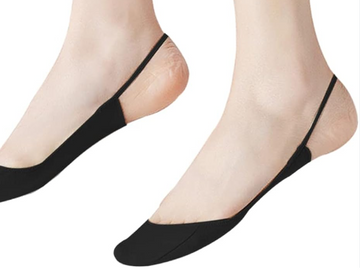
Liner socks might seem like a humble addition to your gear closet, but they can be a game-changer for your feet, especially on adventures. Often worn underneath thicker socks for hiking and backpacking, these thin, breathable wonders offer a surprising number of benefits.
What are Liner Socks?
Liner socks are the ultimate companion for your feet on any adventure, especially hiking and backpacking. These lightweight, breathable socks act like an undershirt for your feet. Worn underneath a thicker pair of socks, they excel at wicking away moisture, keeping your feet dry and comfortable. This is crucial for preventing blisters, a hiker's worst enemy.
But liner socks offer more than just blister prevention. They create a thin, comfortable barrier between your foot and the outer sock, reducing friction and further minimizing blister risk. Despite their name, liner socks are surprisingly versatile. They add a touch of warmth without extra bulk, perfect for long hikes.
Plus, they dry quickly, a huge benefit on multi-day trips where laundry facilities are scarce. Liner socks aren't just for trails – their moisture-wicking properties make them great for running, walking, or any activity where keeping your feet happy is a priority. And for low-impact days, you can even wear them on their own for a lightweight, breathable feel. So, whether you're conquering a mountain or just running errands, liner socks are a simple addition that can make a big difference in keeping your feet comfortable and blister-free.
Why Wear Liner Socks?
Liner socks, those thin, often overlooked companions, offer a surprising number of benefits for your feet.
- Moisture Management Masters: Liner socks excel at wicking away sweat, keeping your feet dry and comfortable. This is crucial for preventing blisters caused by friction between your skin and wet socks.
- Blister Prevention Powerhouse: By creating a barrier between your foot and the outer sock, liner socks significantly reduce friction, a major factor in blister formation.
- Comfort Boost Without the Bulk: Despite their name, liner socks are surprisingly comfortable. They add a thin layer that provides cushioning and reduces friction without adding unnecessary bulk, perfect for long treks.
- Quick-Drying Champions: Liner socks dry quickly, a huge advantage on multi-day adventures where laundry options are limited. Wash them at night, and they'll be ready to conquer the next day's trail.
- Versatility Beyond the Trail: Liner socks aren't just for hiking! Their moisture-wicking properties make them great for running, walking, or any activity where keeping your feet dry and comfortable is a priority.
- Solo Option for Low-Impact Days: For low-impact activities, you can even wear liner socks on their own for a lightweight, breathable feel.
Liner socks are a simple addition that can make a big difference in your comfort and performance. They'll keep your feet happy, blister-free, and ready to take on any adventure!
When Liner Socks Become Your Feet's Best Friends?
Liner socks, those thin wonders, might seem like a niche item, but they shine in a surprising number of situations.
- Hiking and Backpacking: This is their natural habitat. Liner socks wick away sweat, prevent blisters, and add a touch of comfort without extra bulk – perfect for long treks.
- Running and Walking: Liner socks keep your feet dry and comfortable during any activity that gets your heart rate up.
- Multi-Day Adventures: The quick-drying nature of liner socks is a lifesaver on trips where laundry facilities are scarce.
- Hot Weather: Liner socks made with moisture-wicking materials like COOLMAX can help keep your feet cool and dry in hot weather.
- Cold Weather: Merino wool liner socks offer natural warmth and moisture-wicking properties, making them ideal for cold-weather activities.
- Unpredictable Conditions: Liner socks with features like temperature regulation (Merino wool) are great for adventures where the weather might change unexpectedly.
- Blister Prone Feet: Liner socks create a barrier against friction, a major factor in blister formation.
- Layering System or Solo Act: Wear them under thicker socks for maximum benefits, or wear them on their own for low-impact activities where breathability is key.
Liner socks are a versatile addition to your gear closet. From conquering mountains to running errands, they can keep your feet comfortable and blister-free, no matter the activity or conditions.
Blisters: What Causes Those Painful Bubbles?
Blisters are those pesky fluid-filled bubbles that form between layers of your skin. They can put a real damper on any activity, turning a fun hike or run into a miserable experience. But what exactly causes these painful pockets?
- Friction Frenzy: Friction is the arch-enemy of blister-free feet. When your shoes or socks rub repeatedly against your skin, it creates irritation and eventually breaks down the skin, leading to a blister. This can happen if your shoes are too tight or too loose, or if your socks bunch up inside your shoes.
- Improper Shoe Fit: Shoes that don't fit well are a recipe for blisters. Shoes that are too tight restrict movement and create hot spots. Conversely, shoes that are too loose allow your foot to move around too much, causing friction. Finding shoes that fit your feet perfectly and are appropriate for the activity you're doing is key.
- Sock Slippage and Bunching: Loose or ill-fitting socks are a major cause of blisters, especially with liner socks. While liner socks can be helpful for moisture management, if they bunch up or slip around inside your shoes, they can create friction points just like any other sock. Modern sock technology offers better fit and moisture-wicking materials, so a good quality hiking sock might eliminate the need for liners altogether.
- Moisture Madness: Sweat and wet conditions are another enemy of blister-free feet. When your feet are wet, your socks can become soggy and lose their shape, leading to bunching and friction. Moisture-wicking socks made from materials like merino wool can help keep your feet dry and prevent this issue.
- Foreign Invaders: Tiny rocks, dirt, or debris inside your shoes can rub against your skin and create hot spots that turn into blisters. Regularly cleaning your shoes and insoles, and using gaiters in particularly dirty or wet conditions, can help keep these unwanted guests out.
By understanding these common causes, you can take steps to prevent blisters and keep your feet happy on your next adventure!
Are liner socks the same as no show socks?

Liner socks and no-show socks are related but not the same.
Liner socks: These are very thin socks, often reaching the mid-calf or ankle, designed to be worn underneath another pair of socks. Their primary purpose is to wick away moisture and reduce friction, helping to prevent blisters.
No-show socks: These are low-cut socks designed to be hidden entirely within your shoes, creating a sockless look. They offer minimal coverage and focus on keeping your feet comfortable without showing.
Can you wear liner socks on their own?
Yes, you can absolutely wear liner socks on their own! While traditionally used for hiking and backpacking under thicker socks, liner socks offer several benefits that make them great for solo wear.
Pros
Lightweight and Breathable: Liner socks are designed to be thin and breathable, perfect for low-impact activities where keeping your feet cool and comfortable is key.
Moisture Management: Even on their own, liner socks can still wick away sweat, keeping your feet dry and preventing any discomfort or odor buildup.
Versatility: Liner socks are great for activities like running, walking, lounging around the house, or even sleeping in hot weather.
Cons
Activity Level: Liner socks might not provide enough cushioning or support for high-impact activities like jumping or playing sports.
Shoe Choice: Since liner socks are low-cut, they might not work well with all types of shoes, especially those that come up high on the ankle.
Warmth: Liner socks typically offer minimal warmth. If warmth is a priority, consider a thicker sock option.
Overall, liner socks are a versatile option that can be worn on their own for many activities. They offer breathability, moisture management, and a comfortable fit, making them a great addition to your sock drawer.
Are liner socks good?
Liner socks can be quite good, especially for certain activities! Here's a breakdown of their pros and cons to help you decide.
Pros
Blister Prevention: Their primary benefit is reducing friction between your foot and outer sock, a major cause of blisters.
Moisture Management: They wick away sweat, keeping your feet dry and comfortable, which also helps prevent blisters.
Comfort Boost: They add a thin layer for cushioning and reduce friction without extra bulk, perfect for long hikes or activities where comfort matters.
Quick Drying: They dry quickly, a huge advantage on multi-day adventures or for sweaty activities.
Versatility: They're not just for hiking! They're great for running, walking, or any activity where keeping your feet dry and comfortable is a priority.
Can be worn alone: For low-impact activities, liner socks offer breathability and moisture-wicking properties on their own.
Cons
Not necessary for everyone: If you don't suffer from blisters and your feet are comfortable in your regular socks, you might not need them.
May not be suitable for all shoes: Since they're low-cut, they might not work well with high-top shoes.
Limited warmth: They offer minimal warmth, so not ideal for cold weather activities.
Overall, liner socks are a great option for many people, especially those who:
- Hike or backpack frequently
- Get blisters easily
- Want to keep their feet dry and comfortable during exercise or other activities
If you're unsure, they're worth trying! They're a relatively inexpensive way to potentially improve your foot comfort and prevent blisters.
Do liner socks add warmth?
Liner socks themselves add minimal warmth to your feet. Their primary function is moisture-wicking and blister prevention, not insulation.
Liner socks can help keep your feet feeling warmer in certain situations. By wicking away sweat, they can help prevent your feet from getting damp and cold. Wet feet lose heat much faster than dry feet.
What is the difference between liner and low cut socks?
Liner Socks
Coverage: Very thin and short, typically reaching the ankle or mid-calf.
Purpose: Designed to be worn underneath another pair of socks.
Focus: Moisture-wicking and blister prevention by reducing friction between your foot and the outer sock.
Benefits: Keeps feet dry and comfortable, prevents blisters, adds a thin layer for comfort without bulk.
Drawbacks: Limited warmth, may not work well with all shoes (especially high-tops).
Low-Cut Socks
Coverage: A bit longer than liners, usually reaching just above the ankle bone.
Purpose: Worn on their own, creating a low-profile look.
Focus: Provide basic foot coverage and comfort with some moisture management.
Benefits: Offer a sockless look, comfortable for low-impact activities, might protect the back of your ankle from shoe rub.
Drawbacks: May not be as effective at moisture-wicking as liners, less protection from blisters compared to liners worn under thicker socks.
Do wearing sock liners prevent blisters?
Liner socks can be very effective at preventing blisters. Their primary function is to wick away sweat from your feet. Wet feet are more prone to blisters because they soften the skin and increase friction. By creating a thin barrier between your foot and the outer sock, liner socks reduce friction, another major cause of blisters.
Final Words
Liner socks are a simple addition that can make a big difference in your comfort and performance. They'll keep your feet happy, blister-free, and ready to take on any adventure! Whether you're conquering mountains or running errands, liner socks are a versatile choice to keep your feet comfortable and dry.
Read More:
Why Do We Wear Socks
Do You Wear Socks with Climbing Shoes
What Color Socks with Brown Shoes
What Socks to Wear with Loafers
What are Grip Socks
What Socks to Wear with Cowboy Boots
Are Wool Socks Good for Summer




